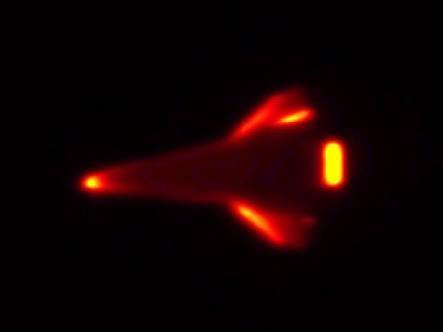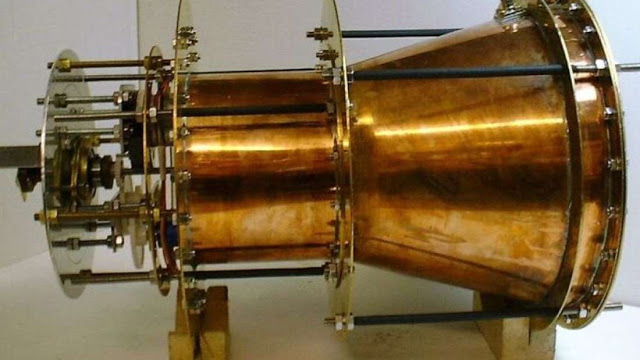The Shuttle’s Thermal Protection System (TPS)
By Dennis R. Jenkins
Originally found at: https://history.nasa.gov/sts1/pages/tps.html
During the original studies of lifting-reentry vehicles during the late 1950s and 1960s, there had been a great debate over the relative merits of active cooling systems versus passive systems for the vehicle structure. The active systems were attractive—on paper—but nobody could quite figure out how to make them work. Therefore, the choices were largely narrowed to either a hot-structure, like that used on the X-15, or a more conventional structure protected by some sort of insulation. The hot-structure approach required the use of rare and expensive superalloys, and there was always a great deal of doubt whether it would have worked on a vehicle as large as the Shuttle. Generally, most contractors seemed to prefer a fairly conventional structure made of titanium and protected by a series of metallic shingles with a thick layer of insulation in between the two. There was some investigation into ablative coatings, but the unhappy X-15A-2 experience made just about everybody shy away from this technology except as a last resort.
Things began to change as the Lockheed Missiles and Space Company made quick progress with the development of the ceramic reusable surface insulation (RSI) concept. This work had begun during the late 1950s, and by December 1960, Lockheed had applied for a patent for a reusable insulation material made of ceramic fibers. The first use for the material came in 1962 when Lockheed developed a 32-inch-diameter radome for the Apollo spacecraft; it was made from a filament-wound shell and a lightweight layer of internal insulation cast from short silica fibers. But the Apollo design changed, and the radome never flew.1
However, the experience led to the development of a fibrous mat that had a controlled porosity and microstructure called Lockheat®. The mat was impregnated with organic fillers such as methyl methacylate (Plexiglas) to achieve a structural quality. These composites were not ablative—they did not char to provide protection. Instead Lockheat evaporated, producing an outward flow of cool gas. Lockheed investigated a number of fibers—silica, alumina, and boria—during the Lockheat development effort. By 1965, this had led to the development of LI-1500, the first of what became the Shuttle tiles. This material was 89 percent porous, had a density of 15 pounds per cubic foot, appeared to be truly reusable, and was capable of surviving repeated cycles to 2,500 degrees Fahrenheit. A test sample was flown on the Air Force Pacemaker reentry test vehicle during 1968, reaching 2,300 °F with no apparent problems.2
Lockheed decided to continue the development of the silica RSI but would produce the material in two different densities to protect different heating regimes—9 pounds per cubic foot (designated LI-900) and 22 pounds per cubic foot (LI-2200). The ceramic consisted of silica fibers bound together and sintered with other silica fibers, and then glaze-coated by a reaction-cured glass consisting of silica, boron oxide, and silicon tetraboride. Since this mixture was not waterproof, a silicon polymer was coated over the undersurface (i.e., non-glazed) side. This material was very brittle, with a low coefficient of linear thermal expansion, and therefore Lockheed could not cover an entire vehicle with it. Rather, the material would have to be installed in the form of small tiles, generally 6-by-6-inch squares. The tiles would have small gaps between them (averaging about 0.01 inch) to permit relative motion and allow for the deformation of the metal structure under them due to thermal effects. A second concern was the movement of the metal skin directly under an individual tile; since a tile would still crack under this loading, engineers decided to isolate the skin from the tile by bonding the tile to a felt pad, then bonding the felt pad to the skin. Both of these bonds were done with a room-temperature vulcanizing (RTV) adhesive.3
In their Phase C response, Rockwell had proposed using mullite tiles made from aluminum silicate instead of the Lockheed-developed tiles because the technology was better understood and more mature. But the mullite tiles were heavier and potentially not as durable. Given the progress Lockheed had made subsequently, Rockwell and NASA asked the Battelle Memorial Institute to evaluate both candidate systems—an evaluation that the Lockheed product won. But the Lockheed material was not appropriate for all applications. Very high-temperature areas of the orbiter—the nose cap and wing leading edges—would use a reinforced carbon-carbon (RCC) material originally developed by LTV for the Dyna-Soar program. The RCC would provide protection above 2,700 °F, yet it would keep the aluminum structure of the orbiter comfortably below its 350 °F maximum. Tiles were used for the entire underside of the vehicle and for most of the fuselage sides and vertical stabilizer. Black tiles could protect up to 2,300 °F, while white tiles protected up to 1,200 °F. Flexible reusable surface insulation (FRSI) protected areas not expected to exceed 750 °F.4
Interestingly, NASA and Rockwell originally believed that the leeward side (top) of the vehicle would not require any thermal protection. But in March 1975, the Air Force Flight Dynamics Laboratory conducted a briefing for Space Shuttle engineers on the classified results of the ASSET, PRIME, and boost-glide reentry vehicle (BGRV) programs that indicated that leeward-side heating was a serious consideration. The thermal environment was not particularly severe, but it easily exceeded the 350 °F capability of the aluminum skin. FRSI blankets were subsequently baselined for this area.
But in the meantime, another problem had developed—with the tiles themselves. As flight profiles were refined and aero-loads better understood, engineers began to question whether the tiles could survive the punishment. By mid-1979, it had become obvious that in certain areas the tiles “did not have sufficient strength to survive the tensile loads of a single mission.” NASA immediately began a massive search for a solution that eventually involved outside blue-ribbon panels, government agencies, academia, and most of the aerospace industry. As LeRoy Day recalled, “. . . there [was] a case [the tile crisis] where not enough engineering work, probably, was done early enough in the program to understand the detail—the mechanical properties—of this strange material that we were using . . .” 5
The final solution to the tile problem (at least this one) involved strengthening the bond between the tiles and the felt strain-isolation pads (SIP). Analysis indicated that although each individual component—a tile, the SIP under the tile, and the two layers of adhesives—had satisfactory tensile strength, when combined as a system, the components lost about 50 percent of their combined strength. This was largely attributed to stiff spots in the SIP (caused by needling) that allowed the system strength to decline as far as 6 psi instead of the baseline 13 psi. In October 1979, NASA decided on a “densification” process that involved filling voids between fibers at the inner moldline (the part next to the SIP pad) with a special slurry mixture consisting of Ludox (a colloidal silica made by DuPont) and a mixture of silica and water. Since the tiles had been waterproofed during manufacture, the process began by applying isopropyl alcohol to dissolve the water-proofing, then painting the back of the tile with the Ludox. After air-drying for 24 hours, the tiles were baked in an oven at 150 °F for two hours. After a visual and weight check, each tile was re-waterproofed using Dow-Corning’s standard Z-6070 product (methyltrimethoxysilane). The densified layer acted as a “plate” on the bottom of the tile, eliminating the effect of the local stiff spots in the SIP, to bring the total system strength back up to 13 psi.6
But the installation presented its own problems. Rockwell quickly ran out of time to install tiles while OV-102 was in Palmdale—NASA needed to present the appearance of maintaining a schedule, and Columbia’s moving to KSC was a very visible milestone. So in March 1979, Columbia was flown from Palmdale to KSC on the SCA, and quickly moved into the Orbiter Processing Facility (OPF). Just over 24,000 tiles had been installed in Palmdale, with 6,000 left to go. But it now appeared that all of the tiles would need to be removed so that they could be densified.
The challenge became to salvage as many of the installed tiles as possible while ensuring sufficient structural margin for a safe flight. The approach developed to overcome this almost insurmountable challenge was called the tile proof test. This involved the application of a load to the installed tile in order to induce a stress over the entire footprint equal to 125 percent of the maximum flight stress experienced at the most critical point on the tile footprint. This approach could potentially salvage thousands of installed tiles.7
The device used for the proof test employed a vacuum chuck to attach to the tile, a pneumatic cylinder to apply the load, and six pads attached to surrounding tiles to react to the load. Since any appreciable tile load might cause some internal fibers to break, acoustic sensors placed in contact with the tiles were used to monitor the acoustic emissions for any internal fiber breakage. The proof testing not only salvaged tens of thousands of installed tiles, but also revealed those tiles (13 percent failed the proof test) with inadequate flight strengths. The tiles that failed would be replaced with densified tiles.8
Two other techniques were developed to strengthen tiles while they were still on the vehicle. The first involved “thick” tiles—usually on the underside of the orbiter—that were relatively small. As shock waves swept air over these tiles, they tended to rotate, inducing high stresses at the SIP bonds. The solution was to install a “gap filler” that prevented the tile from rotating. However, this solution would not be very effective for small, thin tiles, so a technique was developed where the filler bar surrounding the SIP was bonded to the tiles. This was done by inserting a crooked needle into the tile-to-tile gap and depositing RTV on top of the filler bar. This significantly increased the total bonded footprint and decreased the effects of a shock-imposed overturning moment.9
For the next 20 months, technicians worked three shifts per day, six days per week, testing and installing 30,759 tiles. By the time the tiles were installed, proof-tested, often removed and reinstalled, then re-proof-tested, the technicians averaged 1.3 tiles per man per week. Sometimes it seemed like the workers were making no progress at all. During June 1979, Rockwell estimated that 10,500 tiles needed to be replaced; by January 1980, over 9,000 of these had been installed, but the number remaining had ballooned to 13,100 as additional tiles failed their proof tests or were otherwise damaged. By September 1980, only 4,741 tiles remained to be installed, and by Thanksgiving, the number was below 1,000. It finally appeared that the end was in sight.10
Between April 1978 and January 1979, a team from the AFFDL conducted a review of potential orbiter heating concerns and concluded that the OMS pod might have unanticipated problems. To support the conclusion, the Air Force ran a series of tests at the Arnold Engineering Development Center (AEDC) between May and November 1979, and further tests were run at the Naval Surface Weapons Center shock tunnel in May 1980. It was discovered that the OMS pod structure would deflect considerably more than originally anticipated—the thin 8-by-8-inch tiles were relatively weak under bending loads, and it was feared that the tiles might fracture and separate from the vehicle. Since the tiles had already been installed, a unique solution was developed where each tile was “diced” while still attached to the pod. This involved carefully cutting each of the 8-inch tiles into nine equal parts. Each cut was carefully monitored to ensure that neither the tile nor the underlying structure was damaged. The technique proved so successful that it has subsequently been used on other areas of the orbiter when needed.11
The thermal protection system is subjected to numerous loadings from the severe aerodynamic environment, including shocks and pressure gradients. It was comparatively easy to model these loads for the majority of the tiles because they were on flat surfaces on the orbiter. However, many tiles adjacent to “boundaries” (such as the wing leading edge or the windshield) did not have a simple geometry and were difficult to analyze because they were located in very complex flow fields. To better understand the problem, NASA initiated a combination of flight and wind tunnel testing. The flight testing was undertaken during 1980 at NASA Dryden with a total of 60 flights by a McDonnell Douglas F-15 Eagle and a Lockheed F-104 Starfighter. The F-15 was used to evaluate tiles from the wing leading-edge closeout, wing glove, windshield closeout, and vertical stabilizer leading edge; the F-104 tested tiles from the elevon trailing edge and wing cove/elevon. The tiles were subjected to a variety of aerodynamic load conditions, including flights up to Mach 1.4 and dynamic pressures of 1,140 pounds per square foot. Three wind tunnels were used for tile tests—the 16-foot tunnel at AEDC, the 11-foot supersonic tunnel at NASA Ames, and the 8-foot tunnel at NASA Langley. Various anomalies were uncovered that resulted in at least some of the tiles’ being redesigned and retested.12
The tiles around the windshield posed some unique problems because they were subjected to high stagnation pressures that tried to lift the tiles. All orbiter tiles are machined from blocks of RSI so that the layers of silica material run in a direction generally parallel to the skin of the orbiter. This grain orientation is a thermal requirement to minimize the conduction of heat from the outer moldline to the inner moldline (i.e., through the tile to the skin). However, this grain orientation also causes a reduction in strength because of the relatively low number of fibers that run vertically (perpendicular to the orbiter skin)—the vertical fibers are what a transfer loads to the SIP. Because of the unusual aero-loads around the windshield, researchers decided to machine the tiles with the grain perpendicular to the Orbiter skin to provide twice the strength. But this ran the risk of overheating the aluminum structure. A thermal analysis revealed that the heavy framing around the windows acted as a large heat sink that prevented unacceptable temperatures. Further structural analysis, however, indicated that an adequate margin of safety was still not achieved, so it was decided to bond the portion of the tile that overhung the window directly to the glass (previously it had not been bonded). This provided acceptable safety margins.13
1Tom A. Heppenheimer, History of the Space Shuttle, Volume II: Development of the Shuttle, 1972–1981, a draft manuscript for an upcoming second volume of the official NASA shuttle history. Chapter 6 in the 27 April 1999 version.
2History of the Space Shuttle, Volume II, chapter 6 in the 27 April 1999 version
3Richard P. Hallion and James O. Young, Space Shuttle: Fulfillment of a Dream, Case VIII of The Hypersonic Revolution: Case Studies in the History of Hypersonic Technology, Volume 1, From Max Valier to Project PRIME (1924–1967), Air Force Histories and Museums Program (Bolling AFB DC: U.S. Air Force, 1998), pp. 1159–1160.
4Paul A. Cooper and Paul F. Holloway, “The Shuttle Tile Story,” Astronautics & Aeronautics XIX, No. 1 (January 1981): 24–34; Technology Influence on the Space Shuttle Development, report 86-125C (Houston, Texas: Eagle Engineering, Inc., 8 June 1986), pp. 6-4/5; Space Shuttle: Fulfillment of a Dream, pp. 1159–1160.
5First quotation from “The Shuttle Tile Story,” p. 25; Day quotation from an interview of LeRoy E. Day by John Mauer, 17 October 1983, pp. 5–6, in the files of the JSC History Office; Space Shuttle: Fulfillment of a Dream, pp. 1161–1166.
6William C. Schneider and Glenn J. Miller, “The Challenging ‘Scale of the Bird’ (Shuttle Tile Structural Integrity),” (paper presented at the Space Shuttle Technical Conference (CR-2342) at JSC, 28–30 June 1983), pp. 403–413; Space Shuttle: Fulfillment of a Dream, pp. 1165–1166.
7“The Challenging ‘Scale of the Bird’,” pp. 403–413.
8“The Challenging ‘Scale of the Bird’,” pp. 403–413.
9“The Challenging ‘Scale of the Bird’,” pp. 410–413.
10Space Shuttle: Fulfillment of a Dream, p. 1166.
11“The Shuttle Tile Story,” pp. 24–27; “The Challenging ‘Scale of the Bird’,” pp. 409–410; Space Shuttle: Fulfillment of a Dream, pp. 1160–1163.
12“The Challenging ‘Scale of the Bird’,” pp. 403–413; NASA Dryden Press Release, (no title), 18 January 1980.
13The Challenging ‘Scale of the Bird’,” pp. 403–413.




